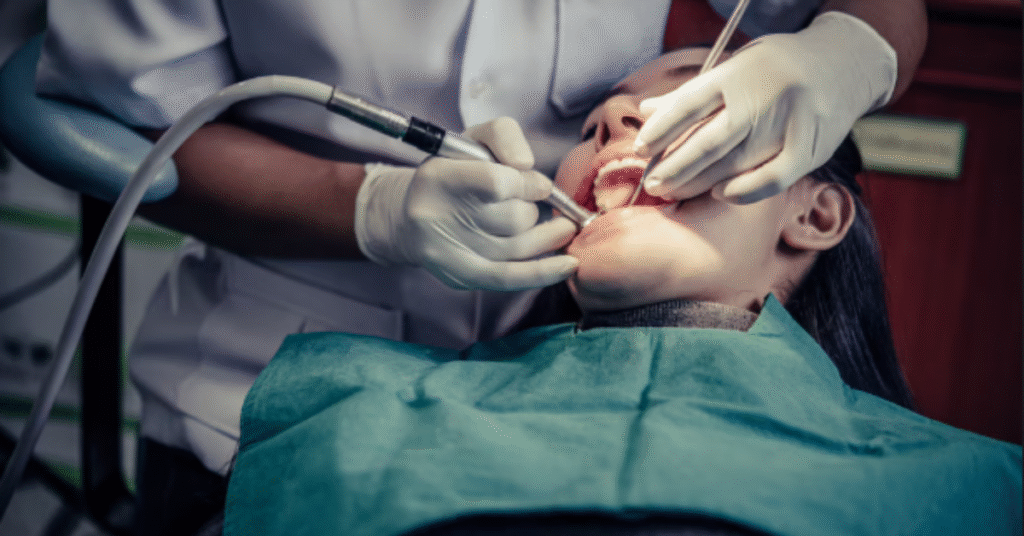Gum graft surgery is a specialized dental procedure designed to restore and protect the gums when they have receded due to periodontal disease, aggressive brushing, or genetics. In simple terms, it involves taking gum tissue from another part of the mouth—usually the palate—and grafting it to the affected area. The main goal is to cover exposed tooth roots, reduce sensitivity, and prevent further gum damage. For many people, gum grafting is not just a cosmetic solution; it’s a crucial step in preserving oral health and preventing tooth loss. Understanding what gum graft surgery involves, how it works, and what recovery looks like helps patients make informed decisions and feel confident in their treatment journey. This article provides an in-depth overview of the entire process—from pre-surgery preparation and procedural details to long-term care, costs, and frequently asked questions—reflecting the depth and precision of expert dental reporting.
Understanding Gum Recession and Why It Happens
Gum recession occurs when the gum tissue surrounding the teeth wears away or pulls back, exposing more of the tooth or its root. This condition can develop gradually, making it difficult for individuals to notice until sensitivity or aesthetic concerns arise. The causes vary—periodontal disease, hormonal changes, misaligned teeth, or even overzealous brushing can contribute. “Gum recession is not just a sign of aging—it’s a warning from your mouth,” says Dr. Emily Rhodes, a periodontist with 15 years of experience in regenerative dental care. Once gum tissue recedes, it cannot regrow naturally, which is why surgical intervention often becomes necessary. Gum graft surgery serves as a biological reinforcement, halting recession and stabilizing the affected area to restore gum line integrity and protect the roots from decay.
Types of Gum Graft Procedures
There are several types of gum graft surgeries, each selected based on the patient’s gum health and specific recession pattern. The three primary types are connective tissue grafts, free gingival grafts, and pedicle grafts. In a connective tissue graft, the surgeon removes tissue from under a flap in the palate and stitches it to the exposed root area—this is the most common method. A free gingival graft, on the other hand, takes tissue directly from the roof of the mouth and attaches it to the receded gums, usually preferred for patients with thin gums. Pedicle grafts use nearby gum tissue that’s partially cut and pulled over the exposed root, maintaining its blood supply for quicker healing. Each method has advantages and limitations, but all share a single purpose: reinforcing the gum line and preventing further deterioration.
Table 1: Types of Gum Graft Surgery and Their Characteristics
| Type of Graft | Source of Tissue | Best For | Healing Time | Primary Advantage |
|---|---|---|---|---|
| Connective Tissue Graft | Beneath palate flap | Moderate to severe recession | 2–4 weeks | Natural color blend and strength |
| Free Gingival Graft | Roof of mouth | Thin gum tissue | 3–5 weeks | Increases gum thickness |
| Pedicle Graft | Adjacent gum area | Localized recession | 2–3 weeks | Preserves blood flow for faster recovery |
The Step-by-Step Gum Graft Surgery Process
A gum graft surgery typically takes between 45 minutes to 90 minutes, depending on the number of teeth affected. The procedure begins with local anesthesia to numb the area. After this, the periodontist identifies the tissue donor site—often the upper palate. For connective tissue grafts, a small incision is made to access tissue beneath the surface. The graft is then carefully sutured over the receded area. In pedicle grafts, the flap from nearby gum tissue is repositioned without completely detaching it. Once sutures are placed, the dentist applies a protective dressing or material that aids healing. The patient is then given post-operative instructions including dietary restrictions and oral care tips. Modern advancements in laser-assisted grafting and tissue bioengineering have also introduced alternatives that minimize discomfort and shorten recovery.
Recovery: What to Expect After Gum Graft Surgery
Recovery from gum graft surgery is generally smooth if proper care is followed. Mild swelling, sensitivity, and discomfort are common during the first few days, but these symptoms gradually subside. Patients are usually advised to eat soft foods such as yogurt, mashed potatoes, or smoothies for the first week to prevent disturbing the graft. Pain management often involves over-the-counter medication, while antibiotics may be prescribed to prevent infection. “The first week after surgery determines how well the graft integrates,” explains Dr. Anthony Wells, an oral surgeon who specializes in regenerative dentistry. During healing, brushing should be avoided in the graft area until cleared by the dentist. Most patients can return to normal activities within two weeks, although full tissue integration may take up to six weeks.
How Long Do Gum Grafts Last?
Gum grafts are designed to be permanent. When successful, the grafted tissue integrates seamlessly with the existing gums, providing lifelong protection. However, maintaining good oral hygiene is critical to ensure the graft’s longevity. Poor brushing habits or untreated gum disease can undermine the success of the procedure. Regular dental checkups every six months and professional cleanings help preserve the graft. Some studies show that well-maintained grafts can last for decades. Patients who follow recommended post-care routines and maintain balanced oral hygiene often experience lasting results both functionally and aesthetically. The goal is not only to protect the teeth but also to restore confidence in one’s smile.
Cost and Factors Influencing Gum Graft Surgery Prices
The cost of gum graft surgery varies based on factors such as location, the extent of gum recession, the type of graft used, and the expertise of the periodontist. On average, gum grafting in the United States can range from $600 to $1,200 per tooth. Insurance coverage often applies if the procedure is deemed medically necessary rather than cosmetic. Additional costs may include anesthesia, consultation, and follow-up visits. Patients should always request a detailed treatment plan and breakdown of costs before proceeding. Technological approaches like laser-assisted grafting or using donor tissue instead of autografts can slightly alter the pricing but often provide more comfort and precision.
Table 2: Average Cost Breakdown of Gum Graft Surgery
| Expense Type | Average Cost (USD) | Coverage Eligibility | Notes |
|---|---|---|---|
| Initial Consultation | $100–$250 | Sometimes | Often credited toward total cost |
| Single Tooth Graft | $600–$1,200 | Yes, if medical | May vary by graft type |
| Anesthesia & Medications | $150–$300 | Partial | Depends on patient sensitivity |
| Follow-Up Visits | $100–$200 | Usually not covered | Includes suture removal and review |
Potential Risks and Complications
Although gum graft surgery is considered safe, potential risks exist as with any surgical procedure. Common complications include bleeding, infection, and graft rejection. Some patients experience prolonged sensitivity at the donor site or slight color mismatch between the grafted and natural gum tissues. These issues typically resolve with time and proper aftercare. In rare cases, if the graft does not integrate successfully, a second procedure might be necessary. The use of advanced microsurgical instruments and sterile techniques has greatly reduced these risks. Surgeons emphasize patient compliance with post-surgical care instructions as the single most important factor in avoiding complications and achieving long-term success.
Benefits Beyond Gum Coverage
Gum graft surgery offers benefits that go beyond aesthetic enhancement. Covering exposed roots significantly reduces tooth sensitivity and risk of root decay. It also improves gumline symmetry, enhancing one’s smile naturally. More importantly, it prevents further gum loss, preserving bone density and supporting tooth stability. “Healthy gums are the foundation of oral wellness,” says Dr. Rachel Moore, a restorative dental specialist. Many patients report not only a boost in self-confidence but also improved oral comfort during eating and brushing. Over time, grafted gums contribute to a healthier oral environment and reduce the likelihood of future dental interventions.
Preparing for Gum Graft Surgery
Before undergoing gum graft surgery, patients must undergo a comprehensive dental evaluation. This includes assessing gum thickness, measuring pocket depth, and checking for infection. The dentist may recommend deep cleaning or scaling prior to surgery to eliminate bacteria. Smoking cessation is strongly advised, as nicotine restricts blood flow and can compromise graft healing. Patients are also instructed to avoid medications like aspirin before the procedure to minimize bleeding. On the day of surgery, comfort is key—most people choose to have someone drive them home afterward. By understanding these preparations, patients can reduce anxiety and ensure an optimal environment for healing.
Nutrition and Lifestyle During Recovery
Post-surgery nutrition plays a significant role in recovery. Foods rich in vitamin C, such as oranges and bell peppers, promote collagen formation and tissue healing. Hydration is equally crucial to maintain oral moisture and prevent irritation. Avoiding crunchy, spicy, or acidic foods helps prevent trauma to the graft area. Additionally, alcohol and tobacco should be avoided during the healing phase. Gentle saltwater rinses can soothe inflammation, but mouthwash with alcohol should be temporarily discontinued. Many dentists recommend a soft diet for two weeks followed by gradual reintroduction of solid foods once the graft has stabilized. Maintaining this balance ensures the graft heals successfully and comfortably.
Gum Grafting and Cosmetic Dentistry
In modern cosmetic dentistry, gum grafting often works hand-in-hand with other treatments such as veneers, crowns, or dental implants. By correcting gum recession first, dentists can achieve more balanced and lasting aesthetic results in subsequent cosmetic work. Gum symmetry enhances the visual proportion of teeth and supports overall facial harmony. Some specialists also use platelet-rich fibrin (PRF) or growth factors to speed up healing and minimize scarring. Integrating grafting with cosmetic procedures ensures a holistic smile restoration—one that’s both functionally and visually refined. It underscores the idea that gum health and beauty are deeply intertwined in comprehensive dental care.
Innovations in Gum Graft Techniques
The field of periodontal surgery has evolved remarkably in recent years. Biocompatible materials such as collagen membranes and allografts (donor tissue) now offer alternatives to traditional grafting methods, eliminating the need for tissue removal from the palate. Laser-assisted gum grafts minimize pain and swelling while accelerating recovery. Regenerative biomaterials are being developed to stimulate natural gum regeneration. “The future of gum grafting lies in tissue engineering and growth factor technology,” notes Dr. Louis Chen, a leading researcher in periodontics. These innovations make gum graft surgery more accessible, less invasive, and increasingly comfortable for patients.
Long-Term Maintenance and Oral Hygiene
Once the graft has healed, maintaining it is relatively straightforward. Gentle brushing with a soft-bristled toothbrush, using fluoride toothpaste, and flossing carefully help prevent plaque buildup. Regular dental cleanings are essential for maintaining gum health. Avoiding aggressive brushing and tobacco use ensures the graft remains intact. Some dentists recommend using an antimicrobial mouth rinse for added protection. For most patients, long-term success is determined by consistent oral hygiene and lifestyle habits. With proper care, the graft not only restores lost tissue but also strengthens the foundation for lifelong oral health.
Psychological and Aesthetic Impact of Gum Graft Surgery
The emotional transformation following gum graft surgery can be profound. Individuals who once avoided smiling due to uneven gum lines often regain confidence after recovery. A symmetrical gum line contributes to facial balance, enhancing expressions and self-assurance. “A confident smile is a reflection of inner health,” remarks Dr. Laura Ortiz, a dental aesthetic consultant. This emotional benefit complements the physical advantages of the procedure. Restoring gum coverage also helps individuals feel more comfortable in social interactions, reinforcing the connection between oral health and overall well-being. The renewed smile becomes both a personal and psychological rejuvenation.
Environmental and Ethical Aspects of Dental Surgery
Modern gum grafting also embraces ethical and sustainable approaches. The use of synthetic or donor tissue reduces the need for self-harvesting, minimizing patient discomfort and aligning with cruelty-free standards. Many dental clinics are shifting toward eco-conscious practices by using biodegradable instruments and energy-efficient sterilization. Ethical dentistry now emphasizes not only patient welfare but also environmental responsibility. Such initiatives reflect a growing recognition that health care must harmonize with ecological awareness. These changes position dentistry as a field evolving beyond technical precision into broader social and environmental consciousness.
Conclusion
Gum graft surgery represents a blend of science, artistry, and precision in modern dentistry. It not only restores gum tissue but also redefines the foundation of oral health. From halting gum recession to improving aesthetic symmetry, its impact extends far beyond the gums themselves. The success of the procedure depends on both the expertise of the periodontist and the patient’s commitment to post-surgical care. As dental technologies advance, gum grafting continues to evolve into a more efficient, less invasive, and more sustainable procedure. Ultimately, it is an investment—not just in dental structure but in overall confidence, comfort, and well-being. “Healthy gums are not a luxury; they’re a necessity for a lifetime of smiles,” reminds Dr. Rhodes. With informed care and ongoing attention, gum graft surgery ensures that every smile can remain strong, protected, and radiant for years to come.
FAQs
Q1. How painful is gum graft surgery?
Pain is minimal during the procedure due to anesthesia. Post-surgery, mild discomfort may occur but can be managed with prescribed medications. Most patients describe it as less painful than expected.
Q2. How long does it take for the graft to fully heal?
Initial healing occurs within 2–3 weeks, but complete tissue integration can take up to 6 weeks depending on the graft type and patient care.
Q3. Can gum grafts fail?
Yes, in rare cases. Factors like poor oral hygiene, smoking, or improper aftercare can cause the graft to detach. However, success rates exceed 90% with proper maintenance.
Q4. Are there non-surgical alternatives to gum grafts?
Mild gum recession can sometimes be managed with composite bonding or pinhole surgical techniques, but advanced cases typically require grafting for effective protection.
Q5. Does insurance cover gum graft surgery?
If gum grafting is medically necessary to prevent tooth loss or decay, many insurance plans provide partial or full coverage. Cosmetic grafting, however, may not be covered.







